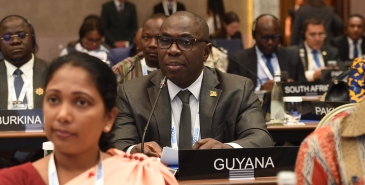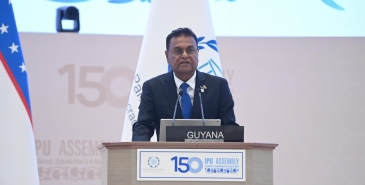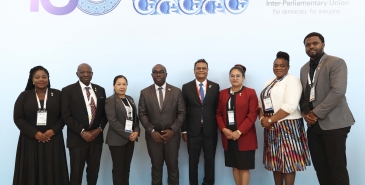Budget Speech Mr Jaipaul Sharma - 2012
Speech delivered at: 9th Sitting - Tenth Parliament - 12 April, 2012
12 April, 2012
4866
Mr. Sharma: Mr. Speaker, please allow me to congratulate the Hon. Minister of Finance for an excellent budget presentation, as he is known for. I would also like to congratulate the staff of the Ministry of Finance and the staff of the Ministries, Departments and Regions who compiled the budget. Nevertheless, the views that will be expressed by me are the reflection of the views of the people of Guyana I represent. As we are the people’s representatives and, therefore, I am obligated to represent their concerns.
After the almost three-hour presentation by the Hon. Minister of Finance Dr. Ashni Singh, on Friday, 30th March, 2012, last, the length of the presentation and the assertions that the $192.8 billion budget is the largest ever, being that that was a 25.1 per cent increase over Budget 2010, gave the erroneous impression that these facts alone make the budget an excellent one. Several times over, the people of Guyana have heard from the Hon. Minister of Finance, Dr. Ashni Singh, of the largest budget ever. What did this mean for the people of Guyana? Did the Government use this largeness to pay the workers a decent living wage or a public assistance increase that is truly meaningful, alternatively, to ensure that old-age pension levels are adequate? Did these largest budgets deal with our most important problem of unemployment and underemployment, energy prices and reliability, flight of skills and, most of all, the tax burden, in particular VAT? Therefore, the people want to know whether this budget offers them a better quality of life and guarantees better quality of services. Whilst most Guyanese use these and other relevant indicators to determine the excellence of a budget, it is the view of many Guyanese that the budget is a disappointment. It is not going to significantly transform the people lives because of the absence of programmes to address the poor and vulnerable including persons with disabilities. The budget pays no attention to the plight of the poor people because there is no development of the human potential and that is the only way this country is going to be transformed. Further, it is the view that the Government's responsibility is to put in place policies that will give the poor and vulnerable people hope and the skills to build their capacity and, therefore, must give priority to projects that increase the level of the income and the creation of permanent jobs.
A preliminary assessment of Budget 2012 will reveal that while there are a few goodies, such as the increase of the income tax threshold, and the increase in pension and public assistance for the citizens, there are all illusions as no real attempt has been made to reduce the burdensome Value Added Tax, or attempt to give any substantial increase in the minimum wages to enable the worker to cope with the rising cost of living. In effect, the $600 increase in pensions, whilst welcome, will mean for the pensioner only a loaf of bread and quarter pound of cheese, and for the $400 increase in public assistance, will mean for the recipients a loaf of bread and a piece of cheese. This increase cannot even buy one packet of the 400 g full cream milk powder that makes three litres of milk. The harsh truth is that we still pay a monthly pension that cannot even buy one week supply of nutritious food.
The Hon. Minister needs to explain that why, after giving an increase on old-age pension and public assistance, the Ministry of Labour, Human Services and Social Security allocation in the Budget 2012 is less than what was allocated in Budget 2011. See page 199 of the Estimates of Public Sector Current and Capital Revenue and Expenditure, Volume 1. Similarly, the increase of the income tax threshold is of no relevance to the thousands of workers categorised as labourers and security guards, office assistants, cleaners, handymen, drivers, clerks and many other workers in the public service and private sector whose gross pay is less than $40,000 per month after the much talk about eight per cent increase in wages and salaries in 2011. Budget 2012 appears to be more of a political management tool. It is a camouflage of figures intended to dazzle and bemuse. It is one designed to bail out Government corporations plagued by inefficiency and mismanagement.
Further, the budget appears to provide, for handing an identified group of contractors, both locally and internationally, large contracts without safeguards on corruption. There was nothing mentioned in the budget about the long awaited Procurement Commission to ensure that contracts to the value of billions of taxpayer dollars are awarded transparently and not siphoned off to handpicked contractors through a flawed tendering process that is currently opened to manipulation, such as the bungled US$15.4 million or $3 billion Guyana currency contract which was handed to Synergy Holding Inc. to build the road to Amalia Falls Hydropower Project. This road was not built as how it was supposed to be done and the money which was paid was over US$8 million. It is now in the court. Now new contracts are being issued to complete this same road. This road which leads to the project is the flagship, which the Hon. Minister mentioned, of this Government. Apparently this ship will not be sailing soon.
Perhaps the greatest travesty of Budget 2012 is the most obvious, blatant abandonment of consultation as part of the preparatory process for it as was agreed upon by the His Excellency, the President, Donald Ramotar. This cannot go unnoticed and must be condemned especially in the context of this new dispensation in which the Joint Opposition Political Parties (JOPP) in the National Assembly represents the majority in this legislature of the Tenth Parliament of Guyana. The Hon. Minister of Finance, Dr. Ashni Singh, declared the theme of this Budget 2012 as Remaining on Course, United in Purpose, Prosperity for All and I concur with it. In fact, it is the views of many Guyanese that Guyana’s economic viability can only be realised if every group and representative of all the segments of our Guyanese society is involved in the decision making process and are beneficiaries of the economic gains. It is the only way that all Guyanese can claim ownership and thereby Remaining on Course, United in Purpose, Prosperity for All.
Value Added Tax: The plight of workers in this country has been compounded by the Government’s intransigence and non-consideration of the rate of VAT. Please bear with me, Mr. Speaker, as I seek to set the background on this very important matter. Guyana had undertaken a major reform of its taxation system. Guyana adopted a VAT Act in 2005. The new tax, which took effect on 1st January, 2007, at a general rate of sixteen per cent, replaced the consumption tax, service tax, hotel accommodation tax, entertainment tax, purchase tax and telephone tax. A relatively large number of goods are zero-rated under the VAT. The Government indicates that it continues a policy of favouring local manufacturers previously provided with a waiver to the consumption tax. The Government noted that the amount of revenue forgone is likely to be minimal. In addition, imports of raw materials are zero-rated if they are used in the production of goods subsequently exported by a taxable person who exports at least forty per cent of the products.
Guyana also enacted the Excise Tax legislation in 2005 and introduced Excise Tax on 1st January, 2007. The Excise Tax was going to be levied on so-called sin and luxury goods, therefore, the tax of these goods VAT plus Excise Tax would result in pre-VAT levels of revenue being collected and the collection of VAT plus Excise Tax would be revenue neutral. Throughout the debate on the VAT Bill in 2005, in the honourable House, the Government Minister emphasised the revenue neutrality of the tax. The honorable House was assured that the solemn intention of the Government was to collect the same amount of money as would be foregone by the taxes that would be scrapped. The Government commissioned an impact assessment study in which a Special Select Committee on VAT and the Excise Tax had the benefit of and it was clearly stated, in that Report, that at the point in which the Report was compiled in 2005, the Hon. Minister of Finance, Dr. Ashni Singh, declared, “… yield a tax that was to be replaced by VAT and Excise Tax for $16.4 billion and therefore represented a revenue neutrality in 2005.”
It is a deliberate judgement, the Government used the combined figure of $24.8 billion as projected revenue from the VAT and Excise Tax, no doubt building into those figures the projected growth in imports which would also, in the previous regime, have attracted consumption taxes and some of the other taxes that were in place. Therefore $24.8 billion represents revenue neutrality in 2007 which represent a 5I.22 per cent or $8.4 billion increase over the 2005 figure of $16.4 billion. Further, the VAT collections in 2007 were $37.7 billion which represents a positive revenue yield of approximately 123.8 per cent or $20.3 billion over the 2005 period. A point to note is that in 2000, VAT collected represented 27.6 per cent of total tax revenue. However, interestingly, since this fact was declared the Government avoided talking about the VAT yield, but even more significantly the words "revenue neutrality" suddenly disappeared from its vocabulary. In the Hon. Minister of Finance Dr. Ashni Singh’s budget speech, 2008, on page 12, he stated, and I quote:"The Value Added and Excise Tax yielded collections of $36.7 billion. The increased collections are reflection of the significant increase in imports realised during the year".
In budget debate, 2011, it was significant that the Hon. Minister never spoke of revenue neutrality nor did he concede that there was a positive revenue yield. These terms were studiously avoided even after it was identified that the increase from 2005 was more than 123.8 per cent or $20.38 billion. I challenge the Hon. Minister to prove to this National Assembly that the increases in VAT, then and now, represent and are bore out of an increase in imports. I want to suggest that in naming this budget under the theme “Remaining on Course” I would not like the Government to remain on this course.
The Hon. Minister should come clean because he know that there continues to be a significant windfall, not only because the figure so indicates, but because the Government finds it easy to hand out $10 bail out - $4 billion to GuySuCo and $6 billion to Guyana Power and Light (GPL). The VAT plus Excise Tax, undoubtedly, contributed positively in the increase expenditure as we see on various activities in the budget, and maybe, there are all deserving items of expenditure. But that is not the point. The Guyanese people, at the minimum, deserve a full explanation, and which is long overdue. These windfall in VAT should have trickle down to the poor in the form of substantial wages and salary increases whereby there is larger percentage increase allocated to the lower level of the salary scales, bands 1 to 6 and bands TS 1 to 9 in the teaching service, and smaller increases allocated to the higher level of the salary scale, for example, bands 7 to 14 in the public service and bands TS 10 to 19 in the teaching service. This would in no way negatively affect the collection of VAT since money in the hands of the poor would mean increase spending as against money in the hand of the rich which would mean increase savings and overseas vacation trips, not benefiting positively the collection of VAT.
Maybe, the Hon. Minister may see it fit to ultimately reduce the VAT from sixteen per cent to fourteen per cent in the first instance and to deal with the informal economy which deviates taxes. It must be pointed out that the budget submitted by the Hon. Minister of Finance may not include all of the requirements of section 15 (i) of the Fiscal Management and Accountability Act and, therefore, a failure to comply with the requirements of the law. It is stipulated, that, and I quote:
“estimates of all statutory expenditures, for the past relevant years, the current fiscal, year, the next ensuing fiscal year and the next following three fiscal years;”
This is not an option that the Minister has if he is to comply with the law. Further, it is a requirement under what is supposed to be a hallmark legislation guiding us in the area of fiscal management and accountability. Section 15 (j) states that:
“estimates of expenditures for investment by each budget agency for the next ensuing fiscal year and the next following three fiscal years;”
The Hon. Minister, in his respond, may say that these are the requirement of each budget agency submission to the Ministry of Finance, but not a requirement for the Ministry of Finance. Why burden the budget agencies to submit this information and not simply include this information for the benefit of this honourable House? When the Government treats the representatives of the people here, in this National Assembly, with such contempt and when it fails to comply with the law, ought we not to be surprised that respect for and compliant with the law within this body politics of our society is steadily diminishing? Further, up to the year 2005, Volume 1 of the Estimates of the Public Sector Current and Capital Revenue and Expenditure included, in respect of staffing details for each agency, the number of authorised positions alongside the number of positions filled. In addition, Volume 1 of the Estimates of the Public Sector Current and Capital Revenue and Expenditure includes, in respect of Appendix Q, a list of pensionable post under Ministries, Departments, Regions, the number of authorised positions alongside the salary scale. It must be noted that in 2006 the column showing the number of authorised positions was mysteriously dropped without any explanation whatsoever, and this situation has repeated itself in the Estimates throughout the tenure of the Hon. Minister Dr. Ashni Singh. Although this is a concern to which the Hon. Minister was alerted in the past, nothing was done to rectify this anomaly to date. The question that arises is why…
The question that arises is why has there been no explanation to the people's representatives here? And what is the harm, or mischief, if the authorised position shown expects to show the level of vacancies in the budget agencies, which is being now occupied by contracted employees?
In concluding, whilst the Budget 2012 does not indicate any increase in the wages and salaries of public servants… However perusal of Volume 1 of the Estimates of the Public Sector Current and Capital Revenue and Expenditure, page 44, Agency: 03 Ministry of Finance, Programme: 031 - Ministry Administration, under line item 6141 – “Revision of Wages and Salary”, a sum of $3.742 billion was budgeted which would indicate that the Ministry of Finance has set aside sufficient funds to pay a possible five per cent increase in wages and salaries across the board, so yet there is hope for the people. Thank you. [Applause]
Speech delivered by:
What's New

08 April, 2025
Minister Kwame McCoy promotes Low Carbon Development Strategy in IPU Committee Meeting on Sustainable Development

07 April, 2025
Speaker Nadir Emphasises Guyana’s Commitment to Social Development at IPU General Debate

07 April, 2025
Guyana Delegation Attends 150th Inter-Parliamentary Union Assembly in Tashkent, Uzbekistan

28 March, 2025
University of Guyana Berbice Campus Orators’ Mastery Society Youth Group Clinches Second Win for Region 6 in the Speaker’s Regional Youth Debating Competition 2025

